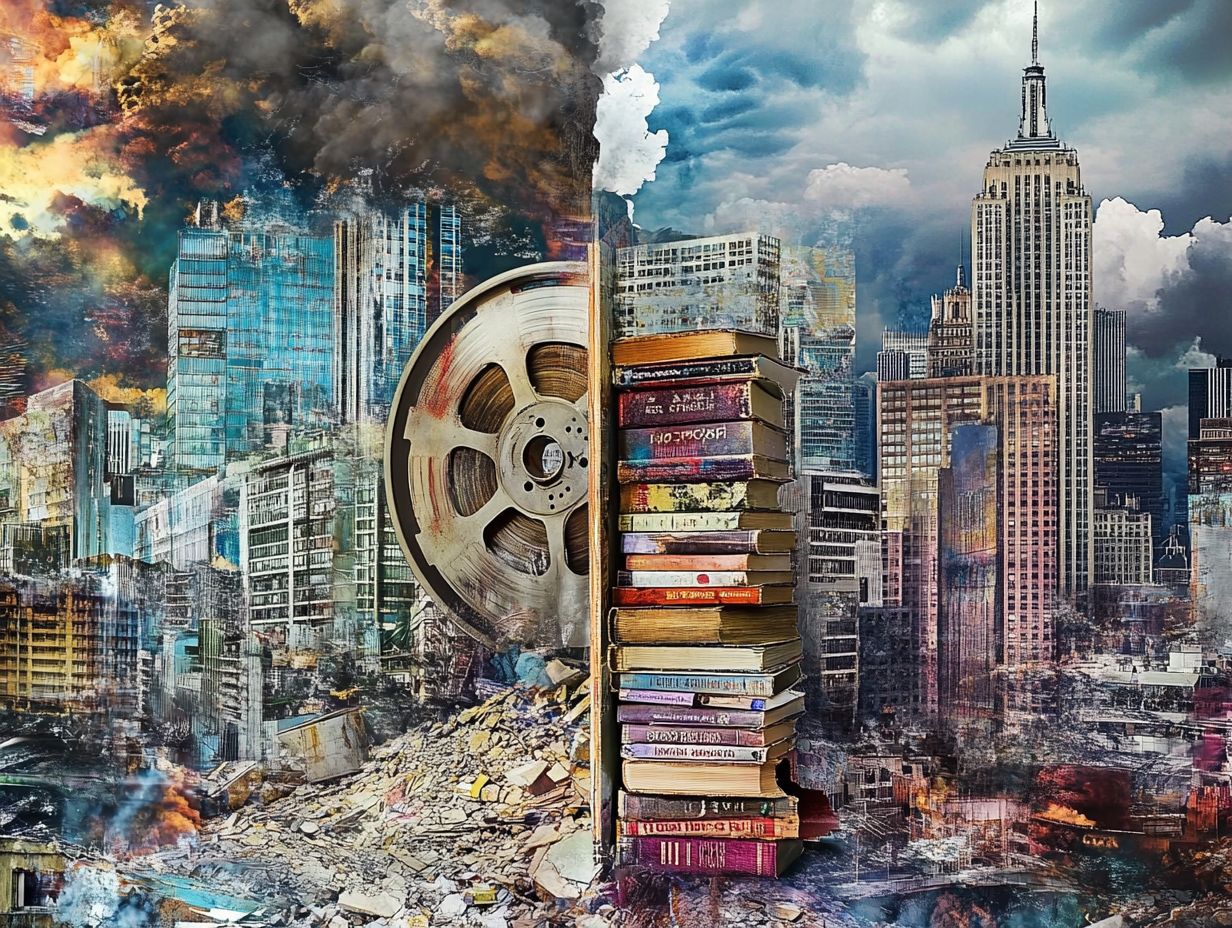Doomsday narratives have captivated audiences for decades, intricately weaving tales of apocalyptic scenarios that resonate with fundamental fears and curiosities.
This article examines the allure of these end-of-the-world stories, investigating their impact on popular culture and society’s collective psyche. From the prevalent themes in films and literature to the psychological effects they invoke, we seek to elucidate the reasons behind our fascination with the darker aspects of existence.
Furthermore, we will discuss constructive methods for coping with the anxiety that these narratives may provoke, offering insights into how individuals can manage their fears while still appreciating the intrigue of doomsday tales.
The Fascination with Doomsday

In an age marked by escalating global crises and the persistent threat of disaster, the intrigue surrounding doomsday scenarios has captured the human imagination, prompting an exploration of apocalyptic and survival narratives in both literature and film.
This interest is evident in various representations of dystopia, encompassing concerns such as the fear of nuclear conflict and the dire consequences of climate change, which contribute to our collective anxiety and inspire compelling storytelling across diverse genres, including science fiction and horror.
The cultural significance of these narratives is profound, as they often serve both as a reflection of and a commentary on societal fears, ultimately influencing our perceptions of apocalyptic outcomes.
Why Are We Drawn to Apocalyptic Stories?
The appeal of apocalyptic narratives lies in their capacity to engage with profound societal fears and existential anxieties, offering a framework through which to examine the vulnerability of civilization and the moral complexities associated with survival situations.
These stories frequently illustrate a stark dichotomy between the heroism demonstrated by certain characters and the misanthropy exhibited by others, thereby reflecting our intricate relationship with society. Audiences are often captivated by the challenges faced by protagonists who embody hope and resilience in the midst of chaos, eliciting both admiration and reflection.
In contrast, the depiction of humanity’s darker inclinations serves as a cautionary narrative, urging audiences to contemplate their own values and ethical limits.
Ultimately, apocalyptic tales transcend mere entertainment; they compel individuals to confront uncomfortable truths about human nature and societal constructs, fostering profound introspection regarding the essence of survival and the sacrifices one may be prepared to make in that pursuit.
Impact of Doomsday in Pop Culture

The impact of doomsday narratives in popular culture is significant, as they shape societal fears and beliefs through various forms of media, including blockbuster disaster films and critically acclaimed literature.
These narratives engage audiences in discussions about morality, survival, and the potential for societal collapse. Often, they resonate with contemporary global crises and reflect underlying cultural anxieties, positioning themselves as more than mere entertainment; they serve as a form of cultural commentary that influences audience perception.
The manner in which these stories are conveyed—through diverse narrative structures and cinematic techniques—plays a critical role in how they are received and comprehended.
Influence on Society’s Fears and Beliefs
Doomsday narratives exert considerable influence over societal fears and beliefs, often exacerbating cultural anxiety and shaping perceptions of imminent catastrophe through the lens of mass media and psychological thrillers.
These narratives engage with deep-seated anxieties regarding the future and the unknown, resonating with audiences by examining the psychological impact of disasters on individuals and communities. As individuals confront the possibility of societal collapse, the ethical dilemmas presented in these narratives—such as the conflict between survival and altruism—compel viewers and readers to reflect on their values and priorities during times of crisis.
Mass media, encompassing films like *The Road* and television series such as *The Walking Dead*, plays a critical role in constructing these scenarios, influencing public perception by providing a sense of realism that blurs the boundaries between fiction and reality.
Through this process, these narratives not only serve to entertain but also stimulate vital discussions regarding humanity’s resilience and moral choices in the face of adversity.
Common Themes in Doomsday Media

Common themes in doomsday media frequently center on societal collapse, survivalism, and the moral dilemmas encountered by characters in disaster scenarios. These narratives illustrate humanity’s struggle against insurmountable odds and the existential questions that arise in the face of calamity.
From iconic films portraying alien invasions to dystopian novels examining the consequences of climate change, such narratives underscore both the fragility of civilization and the resilience of the human spirit. Ultimately, they engage audiences in a profound thematic exploration of ethics, heroism, and the complexities of the human condition.
Exploring End-of-the-World Scenarios
Exploring end-of-the-world scenarios within fictional universes provides a profound opportunity to examine various threats to humanity, including the potential repercussions of technological advancements, ecological disasters, and the influence of folklore on our understanding of catastrophe.
These narratives encompass a range of unsettling possibilities, from the immediate dangers represented by climate fiction, which mirrors contemporary environmental concerns, to the haunting specters of nuclear warfare that echo historical anxieties. The concept of alien invasions frequently serves as a metaphor for societal fears related to the unknown and a loss of control.
Through these vivid portrayals, audiences are encouraged to confront their vulnerabilities and the complexities of human behavior in the face of adversity. Ultimately, these stories not only serve to entertain but also stimulate critical reflection on resilience and the potential for redemption amidst chaos.
Psychological Effects of Doomsday in Pop Culture

The psychological effects of doomsday narratives in popular culture can be significant, impacting mental health and cultivating collective fear among audiences as they engage with themes of catastrophe and survival.
These narratives frequently elicit intense emotions and provoke existential inquiries, prompting individuals to confront their profound anxieties regarding societal collapse and the future of civilization.
How Doomsday Narratives Affect Our Minds
Doomsday narratives can exert a significant influence on individuals’ psychological states, frequently resulting in increased anxiety and fearmongering. However, they may also provide a form of catharsis, enabling individuals to confront their fears and cultivate effective coping mechanisms for managing collective anxieties.
The dynamic interplay between fear and give the power toment inherent in these narratives elicits a complex emotional response. As individuals engage with the alarming possibilities depicted in these stories, they may simultaneously discover strength in their resilience and their capacity to envision survival scenarios. This contrast between dread and hope can profoundly shape personal perspectives, fostering a proactive stance toward life’s uncertainties.
Psychological thrillers often employ these themes to captivate audiences, forging a connection with their own fears while concurrently presenting an avenue for escape. Through engaging plots and relatable characters, viewers are afforded the opportunity to navigate their anxieties, transforming fear into a narrative that give the power tos rather than immobilizes.
Coping with Doomsday Anxiety
Addressing doomsday anxiety necessitates a comprehensive approach that incorporates effective strategies to manage fears and concerns, while also acknowledging the influence of narratives in shaping our perceptions of societal threats.
By engaging with media that resonates with these anxieties and offers reassurance, individuals can better navigate their emotions and cultivate resilience in the face of perceived crises.
Healthy Ways to Address Fears and Concerns
Addressing fears and concerns associated with doomsday anxiety in a healthy manner is essential for maintaining mental well-being. This can be accomplished through the exploration of supportive narratives and active community engagement.
By participating in community support systems, individuals have the opportunity to connect with others who share similar fears, thereby significantly reducing feelings of isolation. Engaging in positive narratives—through storytelling, group discussions, or local initiatives—enables individuals to reframe their anxiety into actionable steps that benefit their communities.
It is imperative to transform feelings of dread into constructive conversations, promoting resilience and understanding rather than despair. Encouraging practices such as mindfulness, volunteerism, and the creation of supportive networks can give the power to individuals to collectively confront their fears, reinforcing the notion that facing challenges is more manageable when approached collaboratively.


